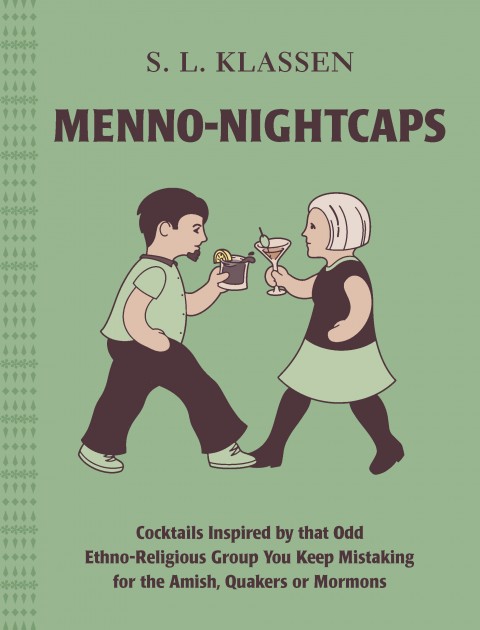 It can be difficult to make new friends. Especially if you are an adult. Especially if you are seeking to befriend a Mennonite.
It can be difficult to make new friends. Especially if you are an adult. Especially if you are seeking to befriend a Mennonite.
Admittedly, many people never face this problem. There are plenty of non-Mennonites out there who are amenable to friend seekers. I can only imagine that friend seekers who need to resort to courting a Mennonite acquaintance have either alienated all of their other options or have ulterior motives – most likely they are trying to infiltrate our farmers’ sausage smuggling networks.
This post, however, is for that little niche of my readership that might actually and honestly want to be friends with a Mennonite. I encourage those readers who are Mennonites themselves to forward this post to their non-Mennonite acquaintances as a nicely passive-aggressive way of telling them how to up their game as potential friends.
You’re welcome.
This post assumes that you already have a Mennonite acquaintance you would like to convert into a friend. Readers without any Mennonite acquaintances should spend some time hanging out where Mennonites like to congregate – thrift shops, relief sales, and cocktail bars. Once you meet a Mennonite, avoid asking them about bonnets, buggies or Steinbach politicians. You’ll never convert an acquaintance to a friend if you start off on the wrong footing.
Your next task is to learn the particular type of Mennonite with whom you are dealing. Without knowing this, you are liable to commit all sorts of egregious gaffs that only the most forgiving Mennonite will overlook. Broadly speaking, you need first to learn whether you have met a Church-attending Mennonite who sees ethnicity as anathema to Mennonite identity (and might be of any ethnicity), an ethnic Mennonite who can trace their lineage back to the Radical Reformation (but might not attend Church or ascribe to the Mennonite Confession of Faith), or someone who fits into both categories like the overlap region in a Venn diagram. I like to think of these as Intersectional Mennonites (other people call these “Cradle Mennonites”). You will need to vary your friend-seeking strategies based on the kind of Mennonite you wish to befriend.
Learning this is not terribly difficult. While there are many minefields to avoid in a conversation with a Mennonite, a fairly direct “so, do you attend a Mennonite Church in the area, or?” will typically work to suss out the religious from ethnic and non-religious Mennonites. If you are not hoping for an invitation to Church, however, you may want to follow that up with a feigned interest in Mennonite geography and/or meeting house architecture.
How to Befriend a Church-Going Mennonite
If your acquaintance is a solid Church-going Mennonite, you are going to have difficulty. Church takes up most of your acquaintance’s free time and emotional energy. A truly extroverted Menno might take you on as a new friend but if you’re looking to hang out and do lots of fun Non-Church things with your new besty, you might want to look elsewhere.
Most friend-seeking advice will tell you to get out and go places where you have common interests. In this case, you are best placed if you can cultivate in yourself an interest in attending Church services, which will then be a common interest with your potential friend. That might seem extreme if you don’t ascribe to the Mennonite tenets of faith but Mennonites lionize community so much that no one there will think it odd if you say you came as a means of looking for friends. For the first few months, you can even get away without bringing a dish to the potluck.
But all is not lost if you are seeking to befriend a Church-going Mennonite without becoming one yourself. Many a Church-going Mennonite like to have a few non-Menno friends around if only to prove to ourselves that our lives are not as insular as they seem to us and everyone else. To secure one of these coveted positions, you should display a polite interest in theology, hymnology, social justice, and/or hermeneutics while also indicating that you are not open to evangelism. You indicate this by declaring allegiance to some other faith group – the Catholic Workers Movement perhaps, or Quakers.
At some point, you may want to learn the particular breed of Mennonite you have befriended. Again, do not open the conversation by asking about clothes or barn raisings. In fact, I’d suggest not opening this conversation at all. You can quietly Google the name of the Church if you like but it’s best not to talk about it. Mennonites tend to be embarrassed about all our schisms and so we typically just act as if our own branch is the only one that matters. You’ll need to get used to that.
How to Befriend an Ethnic, Non-Church-Going Mennonite
If your acquaintance replies to your Church query by denying that they attend Church, you probably have an ethnic Mennonite on your hands. It is fairly likely that, in response to your query, you received not only a denial of their own Church affiliation, but also a long explanation of their family’s genealogy and migration patterns. Pay attention. I know it is tempting to let your mind wander through such a conversation but if you actually still want to pursue a friendship after withstanding that conversation, you need the information imparted.
In North America, most of the people who self-identify as ethnically Mennonite are part of a diaspora of Mennonites who immigrated in the 19th and 20th centuries from Russia (mostly present-day Ukraine). We aren’t the only ethnic Mennonites, but the Mennonites from Switzerland and South Germany who settled much earlier are less likely to self-identify as Mennonite if they aren’t also religious. That’s not a hard and fast rule – an in-depth study of my own acquaintances and Twitter followers reveals that an increasing number of fallen-away Swiss Mennos are resisting pressure to drop their ethnic identity and are surreptitiously baking shoo-fly pies when no one is looking. So make no assumptions.
Your soon-to-be friend might have left the Church with a good deal of bitterness and still bear the wounds like open sores on their soul. It’ll be hard to know exactly which of our traditional past times will trigger traumatic memories for your new friend. You’ll have to just follow their lead on this one and don’t suggest Dutch Blitz, Rook, shopping for bargains, playing or watching volleyball, choral music, or attending a peace march until it is clear that any of these will be welcome activities. Instead, food is a pretty good bet. Even Post-Mennos who shudder at the sight of the MCC logo will wax nostalgic about verenijke or relief sale doughnuts. Some of the religious Mennonites detest this bit of ethno-nationalism but, who cares? That’s not going to bother your non-Church-going friend.
At some point, your ethnic Mennonite friend will probably try to explain to you what it means to be a Mennonite. You should try to arrange to have that conversation over drinks. It will last awhile and it will only reflect their personal experience. Still, it’s not nice to contradict us even if you do have superior knowledge about Anabaptist history or Ukrainian foods. Just smile and say that all you know about Mennonites you learned from the Drunken Mennonite.
And order another drink.
How To Befriend an Intersectional Mennonite
You might have hit upon that sweet spot in the Menno Venn diagram and found yourself a potential friend who is both Church-going and an ethnic Mennonite. If so, you have sadly found yourself with the worst of both worlds.
A non-Church-going ethnic Mennonite might revel in a few, select aspects of their heritage and introduce you to the wonders of schmauntfat or something else equally wonderful. Not so, we intersectional Mennonites. Never sure whether to embrace or scorn our ethnic identity, we intersectional Mennonites eat our traditional foods with a modicum of guilt and hide our copies of Yasch Siemens behind the latest editions of Geez Magazine whenever company comes to call.
And company will come to call – because we have all sorts of pressure to be hospitable coming at us both from the Church community and from our anachronistically large extended families. Which means you’ll have to stand in line for time to socialize, and go through all sorts of logistical contortions to schedule time just to hang out. Actually, if your pre-friend hasn’t rejected the workaholism of our heritage, forget about hanging out; suggest a work party – some contemporary equivalent of the barn raising, quilting bee or pig butchering. Or a service activity. There’s nothing like knotting blankets with someone to tie up a friendship. I think it’s about shared trauma.
On the upside, we intersectional Mennonites feel that insularity more than the others and so might actually recognize the value of a friendship from outside of the fold. Which is good as long as you don’t mind being our token 100% completely non-Menno friend. It’s not so bad. Some of us aren’t all that comfortable drinking with each other so you could hold that special place called “drinking buddy” in your new friend’s social network. Just bring a bottle of whiskey with you when you drop in, and make sure that no one from the same congregation is watching.
Good luck.
The Old Freundschaft
This is yet another variation of the Old Fashioned but with a special nod to friendship.
- 1 1/2 oz good rye whiskey
- 1/4 oz rhubarb syrup
- 1 dash each of rhubarb and angostura bitters
- homemade maraschino cherries
- ice
Mix together the rhubarb syrup and the bitters in the bottom of a glass. Add the whiskey. Drop in the ice and stir a bit. Garnish with cherries. Make two to share with a friend.




I have a Menno friend who never cooks Menno dishes (though she has a bison fetish), but often takes me out for Sushi. She also boasts about her knowledge of chicken farming the way some boast about their Pilates prowess. I would rather she took me for pizza, and I think of chicken farming as an extreme indoor sport with a complex set of rules that are baffling to a non-Menno person like me. (When I talk to Jesus, I only get an empathetic silence in return.) Does our friendship stand a chance?
Thank you for coming to me for advice. It is indeed true that Mennonites may discuss agriculture more than their non-Mennonite peers may wish. I suggest you pull out a deck of Rook cards next time chicken farming comes up in the conversation as a clever distraction ploy. Don’t give up on your friend; she needs your help.
Don’t believe everything my non-Menno friend writes. Writing is one of his gifts he excels at, so there is a certain amount of fiction above. I have indeed invited him for more than one faspa and made him Mennonite Chicken Noodle Soup, even sharing my Winkler-made Menno noodles and farmer sausage on more than one occasion.
It is a sad fact that there are very few non-Mennonites out there who can truly appreciate the perfection that is faspa. We must be patient. And save your farmers sausage for those who know its worth.
Well now I get why your niece so readily made friends with me (even switching churches after she met me!) She can check off the “has non-Menno friends” box without needing to spend time away from church to socialize with me. (I mean, she does, but given how often the other people involved are Mennonite, I’m not sure that counts.)